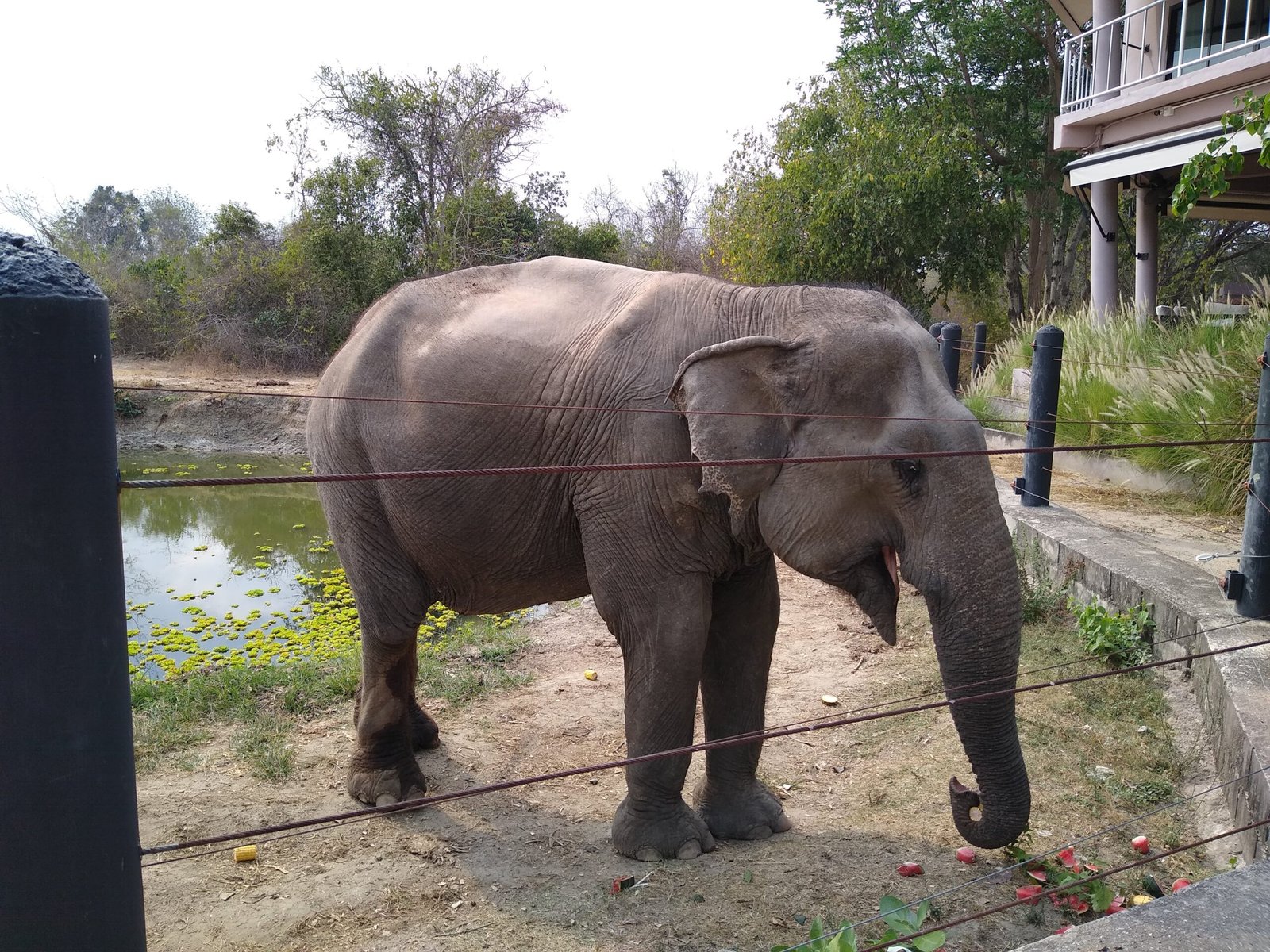Deep in the rolling hills of Tennessee, where the morning mist dances through ancient oak trees, lies a sanctuary that has become home to some of the world’s most remarkable survivors. Here, rescued elephants from circuses, zoos, and private ownership find their second chance at life in a sprawling 2,700-acre haven that mirrors their natural habitat. The trumpet calls that echo across these hills tell stories of resilience, healing, and hope that would make even the hardest hearts skip a beat.
The Gentle Giants Who Call Tennessee Home

The Elephant Sanctuary in Hohenwald, Tennessee, currently houses over a dozen Asian and African elephants, each with their own incredible backstory of survival. These magnificent creatures, some weighing up to 10,000 pounds, roam freely across vast pastures and woodlands that stretch as far as the eye can see. Many arrived here after decades of performing in circuses or living in inadequate zoo conditions, their spirits broken but not destroyed. The transformation that occurs when these elephants first step onto Tennessee soil is nothing short of magical – it’s like watching a caged bird spread its wings for the first time. Some elephants, like Tarra, have become ambassadors for their species, showing the world what true freedom looks like after years of captivity.
From Chains to Freedom: The Journey to Sanctuary

The path that brings elephants to this Tennessee paradise is often heartbreaking, filled with years of exploitation and neglect. Most of these gentle giants spent their lives performing tricks for human entertainment, their natural behaviors suppressed by training methods that would shock most people. The journey to freedom typically begins when circuses retire their elephants or when zoos realize they cannot provide adequate care for such complex creatures. Transportation alone is a massive undertaking – imagine moving a 8,000-pound animal across multiple states in a specially designed trailer that looks more like a mobile mansion than a truck. The moment these elephants arrive at the sanctuary, you can almost see the weight of their past lifting from their massive shoulders.
Tarra’s Incredible Story of Survival

Among the sanctuary’s most beloved residents is Tarra, an Asian elephant whose story reads like a Hollywood script. Born in Burma in 1974, Tarra was captured as a baby and sold to an American circus where she spent over two decades performing tricks and giving rides to tourists. Her life changed dramatically when she arrived at the sanctuary in 1995, becoming one of the first residents of this elephant paradise. What makes Tarra’s story even more remarkable is her unlikely friendship with a dog named Bella, which captured hearts worldwide and proved that elephants form deep emotional bonds that transcend species. Today, at nearly 50 years old, Tarra serves as a matriarch figure, teaching younger elephants the ways of sanctuary life and showing them that trust in humans is possible again.
The Science Behind Elephant Emotions and Intelligence

Scientists have long marveled at the complex emotional lives of elephants, and nowhere is this more evident than at the Tennessee sanctuary. These incredible animals demonstrate self-awareness, empathy, and grief in ways that mirror human emotions, often mourning their dead for days and showing signs of post-traumatic stress from their captive experiences. Research conducted at the sanctuary has revealed that elephants can recognize themselves in mirrors, solve complex problems, and even paint pictures using their trunks as brushes. Their brains, weighing up to 12 pounds, contain the same structures responsible for emotions in humans, explaining why they form such deep bonds with their caregivers and fellow elephants. The healing process observed at the sanctuary often involves elephants literally teaching each other how to be elephants again, passing on natural behaviors that were suppressed during their years in captivity.
Daily Life in Elephant Paradise

A typical day at the sanctuary begins before sunrise, with caregivers preparing massive meals that can include up to 300 pounds of hay, fruits, and vegetables per elephant. The elephants wake naturally with the dawn, no longer forced to perform on human schedules, and begin their day with luxurious mud baths and social interactions that were impossible in captivity. Throughout the day, these gentle giants explore their vast habitat, foraging for food, splashing in custom-built ponds, and engaging in play behaviors that many haven’t experienced since they were babies. The sanctuary’s innovative approach allows elephants to choose their own companions and living arrangements, leading to the formation of complex social groups that mirror those found in the wild. Evening brings peaceful grazing sessions and the kind of tranquil moments that make visitors realize just how much these animals have been through to reach this point.
The Healing Power of Acres and Acres

The sheer size of the Tennessee sanctuary – larger than many small towns – plays a crucial role in the elephants’ physical and psychological recovery. Unlike the cramped quarters of circuses and many zoos, these 2,700 acres provide space for elephants to walk miles each day, just as they would in their natural habitat. The varied terrain includes forests, grasslands, and multiple water sources, allowing elephants to engage in natural behaviors like tree rubbing, dust bathing, and foraging that are essential for their well-being. Studies have shown that elephants at the sanctuary walk an average of 5-8 miles daily, compared to less than a mile in most captive situations, leading to improved joint health and muscle tone. The psychological benefits are even more profound – elephants who once exhibited repetitive stress behaviors like swaying and pacing gradually abandon these habits as they rediscover their natural instincts. Some elephants initially seem overwhelmed by the vastness of their new home, having spent decades in spaces smaller than a typical backyard.
Asian vs African: Understanding the Differences

The sanctuary houses both Asian and African elephants, and the differences between these species are more fascinating than most people realize. Asian elephants, like Tarra, are generally smaller with rounded ears and a single finger-like projection on their trunks, while African elephants sport larger, fan-shaped ears and two trunk fingers that make them more dexterous. The social structures also differ significantly – Asian elephants tend to form smaller, more intimate family groups, while African elephants create larger, more complex matriarchal societies. At the sanctuary, these species are housed separately due to their different social needs and potential for disease transmission, but watching them is like observing two different cultures of the same incredible family. The care requirements vary too, with African elephants needing more calories and different veterinary protocols, making the sanctuary’s work even more complex and specialized.
Veterinary Miracles in the Tennessee Hills

The medical care provided at the sanctuary would rival that of any major hospital, with veterinarians performing everything from routine check-ups to life-saving surgeries on patients that weigh several tons. Many elephants arrive with serious health issues stemming from years of inadequate care, including foot problems, arthritis, and psychological trauma that manifests in physical symptoms. The sanctuary’s on-site veterinary facilities include specialized equipment like hydraulic chutes that can safely restrain elephants for medical procedures and X-ray machines powerful enough to penetrate elephant-thick skin and bone. One of the most remarkable success stories involves an elephant named Sissy, who arrived with severe foot infections that threatened her life but recovered completely thanks to innovative treatment protocols developed specifically for elephants. The veterinary team also conducts groundbreaking research on elephant diseases, contributing to global knowledge that helps wild elephant populations worldwide.
The Friendship That Broke the Internet

The friendship between Tarra the elephant and Bella the dog became a global sensation, proving that elephants form emotional bonds that transcend species barriers. For eight years, this unlikely pair was inseparable, with Bella often riding on Tarra’s back and the two sharing meals and afternoon naps that melted hearts worldwide. When Bella was injured and couldn’t walk to their usual meeting spot, Tarra stood vigil at the sanctuary’s fence, refusing to leave until she could see her canine friend again. The story captured international attention and helped millions of people understand the emotional depth of elephants, leading to increased support for elephant conservation efforts globally. Though Bella has since passed away, her legacy lives on in the countless people who learned about elephant intelligence and emotions through her friendship with Tarra.
Innovative Enrichment Programs

The sanctuary’s enrichment programs read like a luxury resort menu, designed to stimulate the elephants’ minds and bodies in ways that captivity never could. Caregivers hide treats throughout the habitat, encouraging natural foraging behaviors and keeping the elephants mentally engaged for hours at a time. Custom-made toys include massive balls, hanging ropes, and puzzle feeders that challenge the elephants’ problem-solving abilities while providing hours of entertainment. The sanctuary even hosts “elephant art sessions” where residents can paint with specially designed brushes, creating masterpieces that are sold to support the facility’s operations. Water features include not just swimming areas but also sprinkler systems and fountains that allow elephants to play and cool off during Tennessee’s hot summers. These enrichment activities are constantly evolving, with caregivers observing each elephant’s preferences and adjusting programs to meet individual needs and personalities.
The Economics of Elephant Care

Running an elephant sanctuary is like operating a small city, with annual costs exceeding several million dollars to care for just over a dozen residents. Each elephant consumes roughly $70,000 worth of food annually, not including the massive veterinary bills, facility maintenance, and specialized staff salaries required to provide proper care. The sanctuary operates entirely on donations, with no government funding, making every contribution crucial to the elephants’ survival and well-being. Corporate sponsors and individual donors help cover costs for everything from fresh produce to the massive amounts of hay needed to keep these gentle giants healthy and happy. The economic impact extends beyond the sanctuary itself, bringing visitors and volunteer workers to rural Tennessee and supporting local businesses in ways that benefit the entire community. Despite the enormous costs, the sanctuary’s philosophy remains unchanged – no elephant is ever turned away due to financial constraints.
Conservation Impact Beyond Tennessee

The work happening in Tennessee’s hills ripples across the globe, influencing elephant care standards and conservation efforts on multiple continents. Research conducted at the sanctuary has led to improved elephant management practices in zoos worldwide, with findings about elephant behavior and health being shared freely with the international community. The sanctuary’s educational programs reach millions of people annually through virtual tours, documentary films, and educational materials that teach the public about elephant intelligence and conservation needs. Many visitors leave the sanctuary as passionate elephant advocates, supporting wild elephant conservation efforts in Africa and Asia with newfound understanding of these incredible creatures. The facility also serves as a training ground for future elephant caregivers and researchers, with many staff members going on to work in conservation programs around the world. Even the sanctuary’s rescue stories inspire legislative changes, with several states banning elephant performances in circuses after learning about the conditions these animals endured.
Technology Meets Ancient Wisdom

The sanctuary employs cutting-edge technology to monitor elephant health and behavior, including GPS tracking systems that allow caregivers to monitor each elephant’s movements and activity levels throughout the day. Thermal imaging cameras help detect health issues before they become serious, while underwater cameras in the elephants’ swimming areas capture behaviors that researchers have never observed in captive settings. The facility’s innovative elephant cam system allows supporters worldwide to watch the elephants in real-time, creating a global community of elephant enthusiasts who feel connected to these remarkable animals. Advanced water filtration systems ensure that the elephants’ ponds and drinking water meet the highest quality standards, while solar power systems help reduce the sanctuary’s environmental footprint. Despite all this modern technology, the sanctuary’s approach remains rooted in understanding elephant behavior and social needs, proving that sometimes the best innovations come from simply listening to what the animals are trying to tell us.
Challenges and Triumphs of Sanctuary Life

Every day at the sanctuary brings new challenges, from managing the complex social dynamics of rescued elephants to dealing with the massive logistical requirements of caring for creatures this size. Weather presents constant challenges, with Tennessee’s severe storms requiring specialized elephant-proof shelters and winter preparations that would make arctic explorers jealous. The emotional toll on caregivers is significant, as they work with animals who have suffered years of abuse and neglect, requiring a special combination of professional skill and personal resilience. Yet the triumphs far outweigh the challenges – moments like watching a formerly traumatized elephant take her first dust bath in decades or seeing two elephants who were once rivals become best friends. The sanctuary’s success rate in rehabilitating elephants is remarkable, with nearly every resident showing significant improvement in physical and psychological health within their first year of sanctuary life. These victories, both big and small, fuel the dedication of everyone involved in this incredible mission.
The Ripple Effect of Elephant Rescue

The impact of the Tennessee sanctuary extends far beyond its borders, inspiring the creation of similar facilities worldwide and changing public perception about elephant captivity. Major circuses have retired their elephant acts partly due to public awareness campaigns that highlighted the work being done at sanctuaries like this one. Zoos across the country have improved their elephant facilities or chosen to relocate their elephants to sanctuaries, recognizing that these complex animals need more space and specialized care than traditional facilities can provide. The sanctuary’s influence on legislation has been profound, with several states passing laws restricting elephant performances and improving captive elephant welfare standards. Educational programs reach thousands of school children annually, creating a new generation of conservation-minded individuals who understand the importance of protecting both captive and wild elephants. The sanctuary’s model has been replicated in other countries, with similar facilities opening in Brazil, Argentina, and other nations where circus elephants needed retirement homes.
Future Visions for Elephant Sanctuary

The sanctuary’s future plans are as ambitious as they are inspiring, with expansion projects that could double the available habitat for rescued elephants. Plans include specialized facilities for elderly elephants who need extra medical care, as well as advanced research centers that could unlock new secrets about elephant behavior and intelligence. The sanctuary is also exploring partnerships with international conservation organizations to potentially create breeding programs for endangered Asian elephants, though this remains a complex and controversial topic in the elephant care community. Technology improvements are constantly in development, including new tracking systems that could provide even better health monitoring and environmental controls that optimize habitat conditions year-round. The ultimate goal remains unchanged since the sanctuary’s founding – providing the highest quality of life possible for elephants who have suffered in captivity while educating the public about why these magnificent creatures deserve our protection and respect. With continued support from donors and volunteers, the sanctuary’s work will continue inspiring people worldwide to see elephants not as entertainment, but as the intelligent, emotional beings they truly are.
What Tomorrow Holds for These Gentle Giants

As the sun sets over the Tennessee hills, casting long shadows across the sanctuary’s vast pastures, the rescued elephants continue their journey of healing and rediscovery. Each day brings new moments of joy, new friendships, and new proof that with enough space, care, and respect, even the most damaged spirits can find peace again. The sanctuary stands as a testament to what’s possible when humans choose compassion over entertainment, education over exploitation, and love over profit in our relationship with the natural world. These gentle giants, once broken by human greed, now serve as ambassadors for their species and teachers for our own, showing us that true strength lies not in domination but in the courage to care for those who cannot care for themselves. What would you do if you came face to face with one of these incredible survivors?



